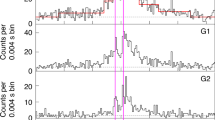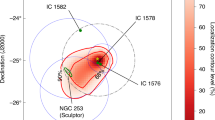Abstract
A new class of ultra-long-duration (more than 10,000 seconds) γ-ray bursts has recently been suggested1,2,3. They may originate in the explosion of stars with much larger radii than those producing normal long-duration γ-ray bursts3,4 or in the tidal disruption of a star3. No clear supernova has yet been associated with an ultra-long-duration γ-ray burst. Here we report that a supernova (SN 2011kl) was associated with the ultra-long-duration γ-ray burst GRB 111209A, at a redshift z of 0.677. This supernova is more than three times more luminous than type Ic supernovae associated with long-duration γ-ray bursts5,6,7, and its spectrum is distinctly different. The slope of the continuum resembles those of super-luminous supernovae8,9, but extends further down into the rest-frame ultraviolet implying a low metal content. The light curve evolves much more rapidly than those of super-luminous supernovae. This combination of high luminosity and low metal-line opacity cannot be reconciled with typical type Ic supernovae, but can be reproduced by a model where extra energy is injected by a strongly magnetized neutron star (a magnetar), which has also been proposed as the explanation for super-luminous supernovae10.
This is a preview of subscription content, access via your institution
Access options
Subscribe to this journal
Receive 51 print issues and online access
$199.00 per year
only $3.90 per issue
Buy this article
- Purchase on Springer Link
- Instant access to full article PDF
Prices may be subject to local taxes which are calculated during checkout



Similar content being viewed by others
References
Gendre, B. et al. The ultra-long gamma-ray burst 111209A: the collapse of a blue supergiant? Astrophys. J. 766, 30 (2013)
Stratta, G. et al. The ultra-long gamma-ray burst 111209A: II. Prompt to afterglow and afterglow properties. Astrophys. J. 779, 66 (2013)
Levan, A. et al. A new population of ultra-long duration gamma-ray bursts. Astrophys. J. 781, 13 (2014)
Nakauchi, D., Kashiyama, K., Suwa, Y. & Nakamura, T. Blue supergiant model for ultra-long gamma-ray bursts with superluminous-supernova-like bump. Astrophys. J. 778, 67 (2013)
Galama, T. et al. An unusual supernova in the error box of the γ-ray burst of 25 April 1998. Nature 395, 670–672 (1998)
Hjorth, J. et al. A very energetic supernova associated with the γ-ray burst of 29 March 2003. Nature 423, 847–850 (2003)
Stanek, K. Z. et al. Spectroscopic discovery of the supernova 2003dh associated with GRB 030329. Astrophys. J. 591, L17–L20 (2003)
Quimby, R. M. et al. Hydrogen-poor superluminous stellar explosions. Nature 474, 487–489 (2011)
Gal-Yam, A. Luminous supernovae. Science 337, 927–932 (2012)
Dessart, L., Hillier, D. J., Waldman, R., Livne, E. & Blondin, S. Superluminous supernovae: Ni power versus magnetar radiation. Mon. Not. R. Astron. Soc. 426, L76–L80 (2012)
Hoversten, E. A. et al. GRB 111209A: Swift detection of a long burst with an optical counterpart. GCN Circ. 12632 (2011)
Golenetskii, S. et al. Konus-Wind observation of GRB 111209A. GCN Circ. 12663 (2011)
Greiner, J. et al. GROND—a 7-channel imager. Publ. Astron. Soc. Pacif. 120, 405–424 (2008)
Virgili, F. J. et al. GRB 091024A and the nature of ultra-long gamma-ray bursts. Astrophys. J. 778, 54 (2013)
Zhang, B.-B., Zhang, B., Murase, K., Connaughton, V. & Briggs, M. S. How long does a burst burst? Astrophys. J. 787, 66 (2014)
Leloudas, G. et al. Spectroscopy of superluminous supernova host galaxies. A preference of hydrogen-poor events for extreme emission line galaxies. Mon. Not. R. Astron. Soc. 449, 917–932 (2015)
Kleiser, I. K. W. et al. Peculiar Type II supernovae from blue supergiants. Mon. Not. R. Astron. Soc. 415, 372–382 (2011)
Mazzali, P. A. & Lucy, L. B. The application of Monte Carlo methods to the synthesis of early-time supernovae spectra. Astron. Astrophys. 279, 447–456 (1993)
Mazzali, P. A. Applications of an improved Monte Carlo code to the synthesis of early-time supernova spectra. Astron. Astrophys. 363, 705–716 (2000)
Kasen, D. & Bildsten, L. Supernova light curves powered by young magnetars. Astrophys. J. 717, 245–249 (2010)
Mazzali, P. A. et al. A neutron-star-driven X-ray flash associated with supernova SN 2006aj. Nature 442, 1018–1020 (2006)
Ryan, G., van Eerten, H., MacFadyen, A. & Zhang, B.-B. Gamma-ray bursts are observed off-axis. Astrophys. J. 799, A3 (2015)
Cano, Z. A trio of gamma-ray burst supernovae: GRB 120729A, GRB 130215A/SN 2013ez, and GRB 130831A/SN 2013fu. Astron. Astrophys. 568, 19 (2014)
Mazzali, P. A. et al. An upper limit to the energy of gamma-ray bursts indicates that GRBs/SNe are powered by magnetars. Mon. Not. R. Astron. Soc. 443, 67–71 (2014)
Quataert, E. & Kasen, D. Swift 1644+57: the longest gamma-ray burst? Mon. Not. R. Astron. Soc. 419, L1–L5 (2012)
Sauer, D. N. et al. The properties of the ‘standard’ type Ic supernova 1994I from spectral models. Mon. Not. R. Astron. Soc. 369, 1939–1948 (2006)
Inserra, C. Super-luminous Type Ic supernovae: catching a magnetar by the tail. Astrophys. J. 770, 128 (2013)
Lunnan, R. et al. PS1–10bzj: a fast, hydrogen-poor superluminous supernova in a metal-poor host galaxy. Astrophys. J. 771, 97 (2013)
Vreeswijk, P. M. et al. The hydrogen-poor superluminous supernova iPTF 13ajg and its host galaxy in absorption and emission. Astrophys. J. 797, 24 (2014)
Yaron, O. & Gal-Yam, A. WISeREP — an interactive supernova data repository. Publ. Astron. Soc. Pacif. 124, 668–681 (2012)
Tody, D. in Astronomical Data Analysis Software and Systems II (eds Hanisch, R. J., Brissenden, R. J. V. & Barnes, J. ) 173 (ASP Conf. Ser. 52, 1993)
Krühler, T. et al. The 2175 Å feature in a gamma-ray burst afterglow at redshift 2.45. Astrophys. J. 685, 376–383 (2008)
Küpcü Yoldaş, A. et al. First results of GROND. AIP Conf. Proc. 1 000, 227–231 (2008)
SDSS. http://www.sdss.org/dr3/algorithms/fluxcal.html (accessed 21 October 2014)
Swift: catching gamma-ray bursts on the fly. http://www.swift.ac.uk/swift_portal (2014)
Poole, T. S. et al. Photometric calibration of the Swift ultraviolet/optical telescope. Mon. Not. R. Astron. Soc. 383, 627–645 (2008)
Schlegel, D., Finkbeiner, D. & Davis, M. Maps of dust infrared emission for use in estimation of reddening and cosmic microwave background radiation foregrounds. Astrophys. J. 500, 525–553 (1998)
Vernet, J. et al. X-shooter, the new wide band intermediate resolution spectrograph at the ESO Very Large Telescope. Astron. Astrophys. 536, A105 (2011)
Krühler, T. et al. GRB hosts through cosmic time: an emission-line survey of 96 gamma-ray burst selected galaxies between 0.1 < z < 3.6. Astron. Astrophys. (in the press); preprint at http://arXiv.org/abs/1505.06743 (2015)
Arnouts, S. & Ilbert, O. Le PHARE: Photometric analysis for redshift estimate. http://www.cfht.hawaii.edu/~arnouts/LEPHARE (2014)
Arnett, W. D. Type I supernovae. I — Analytic solutions for the early part of the light curve. Astrophys. J. 253, 785–797 (1982)
Valenti, S. et al. The broad-lined Type Ic supernova 2003jd. Mon. Not. R. Astron. Soc. 383, 1485–1500 (2008)
Mazzali, P. A. et al. The very energetic, broad-lined Type Ic supernova 2010ah (PTF10bzf) in the context of GRB/SNe. Mon. Not. R. Astron. Soc. 432, 2463–2473 (2013)
Surman, R., McLaughlin, G. C. & Hix, W. R. Nucleosynthesis in the outflow from gamma-ray burst accretion disks. Astrophys. J. 643, 1057–1064 (2006)
Perna, R., Duffell, P., Cantiello, M. & MacFadyen, A. I. The fate of fallback matter around newly born compact objects. Astrophys. J. 781, 119 (2014)
Cardelli, J. A., Clayton, G. C. & Mathis, J. S. The relationship between infrared, optical, and ultraviolet extinction. Astrophys. J. 345, 245–256 (1989)
Acknowledgements
We thank R. Lunnan and E. Berger for providing the spectrum of PS1-10bzj in digital form, and A. Levan for the HST grism spectra of GRB 111209A. J.G., R.D. and D.A.K. acknowledge support by the DFG cluster of excellence “Origin and Structure of the Universe” (http://www.universe-cluster.de). P.S., J.F.G. and M.T. acknowledge support through the Sofja Kovalevskaja award to P.S. from the Alexander von Humboldt Foundation, Germany. C.D. acknowledges support through EXTraS, funded from the European Union’s Seventh Framework Programme for research, technological development and demonstration. S.K., D.A.K. and A.N.G. acknowledge support by DFG. S. Schmidl acknowledges support by the Thüringer Ministerium für Bildung, Wissenschaft und Kultur. F.O.E. acknowledges support from FONDECYT. S.T. is supported by DFG. R.F. acknowledges support by Czech MEYS. Part of the funding for GROND (both hardware as well as personnel) was generously granted from the Leibniz-Prize to G. Hasinger. DARK is funded by the DNRF.
Author information
Authors and Affiliations
Contributions
J.G. led the observing campaign and the paper writing. D.A.K. was responsible for the GROND data reduction, and performed the fitting of the afterglow light curve. F.K. derived the accurate GROND astrometry, P.S. the UVOT photometry, and A.R. the host fitting. P.M. suggested the magnetar interpretation and computed the spectral models. S.P. and C.A. performed the light-curve model fitting. F.O.E. and E.P. assisted in spectral decomposition and the construction of the bolometric light curve. S.T., S.K. and G.L. provided crucial input and discussion. D.A.K., A.N.G., P.M.J.A., J.B., C.D., J.E., R.F., J.F.G., S. Schmidl, T.S., V.S., M.T., A.C.U. and K.V. performed the many epochs of GROND observations. T.K., J.P.U.F. and G.L. provided and analysed the X-shooter spectrum. S. Savaglio, S.K., R.D. and H.v.E. were instrumental in various aspects of the data interpretation.
Corresponding author
Ethics declarations
Competing interests
The authors declare no competing financial interests.
Extended data figures and tables
Extended Data Figure 1 Binning has no effect on spectral slope.
Original X-shooter spectrum in the UVB (a) and VIS (b) arms shown in grey (0.4 Å per pixel; before host and afterglow subtraction), with the re-binned (factor of 20) spectrum overplotted in black. The binning does not change the steepness of the spectrum, in particular not at the blue end. Yellow circles denote positions of atmospheric absorption lines.
Extended Data Figure 2 Long-wavelength spectra.
Full X-shooter spectrum near maximum light of SN 2011kl, as well as two HST grism spectra taken one week before and after the supernova maximum (both taken from ref. 3). Above 500 nm rest-frame, none contain any informative absorption lines (all absorption structures seen are from the Earth’s atmosphere).
Extended Data Figure 3 Step-by-step corrections of the supernova spectrum.
Sequence of analysis steps for the X-shooter spectrum; from the observed spectrum corrected only for galactic foreground (top, very light blue), through host subtraction (light blue) and afterglow+host subtraction (blue) to local host (SMC-like) dereddened (very dark blue). The break at 500 nm observer-frame (300 nm rest-frame) and the steep slope towards the ultraviolet are inherent to the raw spectrum, not a result of afterglow or host subtraction. The coloured data points are the photometric observations in the individual UVOT+GROND+Gemini filters.
Extended Data Figure 4 Observed spectral energy distribution of the host galaxy of GRB 111209A.
Plotted in blue are GROND g′, r′, i′, z′ detections with 1σ errors (crosses) and GROND J, H, KS upper limits (3σ; triangles) of the host galaxy of GRB 111209A. Data taken from ref. 3 are F336W (green), Gemini g′, r′ detections (red crosses) and the J-band upper limit (red triangle). The best-fit LePHARE template of a low-mass, low-extinction, young star-forming galaxy is shown, which is very typical for GRB host galaxies.
Rights and permissions
About this article
Cite this article
Greiner, J., Mazzali, P., Kann, D. et al. A very luminous magnetar-powered supernova associated with an ultra-long γ-ray burst. Nature 523, 189–192 (2015). https://doi.org/10.1038/nature14579
Received:
Accepted:
Published:
Issue Date:
DOI: https://doi.org/10.1038/nature14579
This article is cited by
-
Origin of the elements
The Astronomy and Astrophysics Review (2023)
-
Deformed special relativity with an invariant minimum speed as an explanation of the cosmological constant
Pramana (2022)
-
Time domain astronomy with the THESEUS satellite
Experimental Astronomy (2021)
-
Ultra-Long Gamma-Ray Bursts detection with SVOM/ECLAIRs
Experimental Astronomy (2020)
-
New regimes in the observation of core-collapse supernovae
Nature Astronomy (2019)
Comments
By submitting a comment you agree to abide by our Terms and Community Guidelines. If you find something abusive or that does not comply with our terms or guidelines please flag it as inappropriate.



